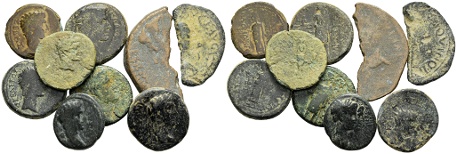Fine Coins Showcase
Antiquities Showcase
Show Empty Categories
Shop Search
Shopping Cart
My FORVM
Contact Us
About Forum
Shopping at Forum
Our Guarantee
Payment Options
Shipping Options & Fees
Privacy & Security
Forum Staff
Selling Your Coins
Identifying Your Coin
FAQs
zoom.asp
Home ▸ Catalog ▸ |Roman Coins| ▸ |Roman Provincial||View Options:   | | | | | | From Augustus (27 B.C. - 14 A.D.) to Tacitus (275 - 276 A.D.), the Roman Empire allowed many provinces and cities to mint coins for local use - those coins are referred to as Roman provincial coins (or Greek imperial coins). Most Roman provincial coins were copper, bronze or brass, but silver provincial coins were also issued. There are three subcategories: colonial (mostly Latin legends), Greek imperial (Greek legends), and quasi-autonomous (issued under Roman authority but without the Emperor's portrait). Roman provincial coins are known from about 600 cities, though after Caligula (37 - 41 A.D.) only cities from Greece eastward issued them. If you are looking for coins of a specific emperor, use the menu on the left. If you are looking for coins from a specific city or region, these coins are organized geographically under Greek Imperial in our Greek Coins pages. The link to our Greek Coins is in the header above. |


The following list was provided by the consignor and has not been verified by FORVM:
1) Augustus, Caius and Lucius, AE28, Julia Traducta, Spain, cut half of a RPC I 107.
2) Claudius (41-54), AE18, Aezanis, Phrygia, Pausanius Menandros, magistrate, Zeus standing left, RPC I 3095 or similar.
3) Augustus, AE18, RPC I 2399, patina flaking at rim.
4) Caligula, AE18, Nero and Drusus jugate, AE18, Philadelphia, Lydia.
5) Tiberius, AE19 (2.95g) Ephesos, no legend, head of Tiberius right / facing statue of Artemis Ephesia, RPC I 2613.
6) Time of Tiberius, AE20, Tripolis, Lydia, RPC I 3055.
7) Augustus or Tiberius, AE20, Laodicea ad Lycus, Phrygia, bare head right / Zeus standing left
8) Claudius, AE20, Aezanis, Phrygia, RPC I 3095.
9) Tiberius, with Nero and Drusus, cut half Æ As of Carthago Nova, Spain, 14 - 37 A.D.
LT112798. Bronze Lot, lot of 9 Julio-Claudian Roman provincial bronze coins, 2 are cut halves, 17.2mm - 31.1mm, mostly F - VF, two are cut halves, c. 20 B.C. - 54 A.D.; no tags or flips, the actual coins in the photograph, as-is, no returns, 9 coins; $260.00 (€244.40)
Marcus Aurelius, 7 March 161 - 17 March 180 A.D., Mostene, Lydia


Mostene, in ancient Lydia, prospered in Roman and Byzantine eras. There is debate, based on a line in Tacitus, over whether Mostene was a Macedonian colony or a native Lydian city. In 17 A.D. the city was hit by an earthquake and was assisted by relief from Tiberius.RP113182. Bronze AE 35, Apparently unpublished; GRPC Lydia -, RPC Online IV -, F, dark green patina, earthen deposits, marks, pit lower right, weight 21.592 g, maximum diameter 35.3 mm, die axis 180o, Mostene (Kepecik, Turkey) mint, c. 161 - 162 A.D.; obverse AVT K M AVPH ANTΩNEINOC, laureate, draped, and cuirassed bust right, seen from behind; reverse EΠI AΛEΞANΔPOY APX ΛYΔ MOCTHNΩN (authority of Alexandros, archon, Mostene), Demeter, holding grain and torch?; from the Michael Arslan Collection, ex Solidus auction 123 (25 Jul 2023), lot 359 (part of); the only known specimen; extremely rare; $250.00 (€235.00)
Trajan, 25 January 98 - 8 or 9 August 117 A.D., Antioch, Seleucis and Pieria, Syria


RP114282. Silver tetradrachm, RPC Online III 3538, McAlee 439, Wruck 158, Prieur 1504, SNG Blackburn 1083, BMC 22, VF, near centered, mild die wear, edge cracks, mild porosity, weight 13.898 g, maximum diameter 26.0 mm, die axis 180o, Antioch (Antakya, Turkey) mint, 110 - 111 A.D.; obverse AYTOKP KAIC NEP TPAIANOC CEB ΓEPM ΔAK (Imperator Caesar Nerva Trajanus Augustus Germanicus Dacicus), laureate head of Trajan right, club on left and eagle on right below; reverse ΔHMAPX EΞ IE UΠAT E (tribunicia potestate XV consul V), eagle standing facing on club left, wings open, head and tail left, palm frond upright on right curving left; $250.00 (€235.00)
CLICK HERE TO SEE MORE FROM THIS CATEGORY - FORVM's PRIOR SALES
Page created in 1.11 seconds.









